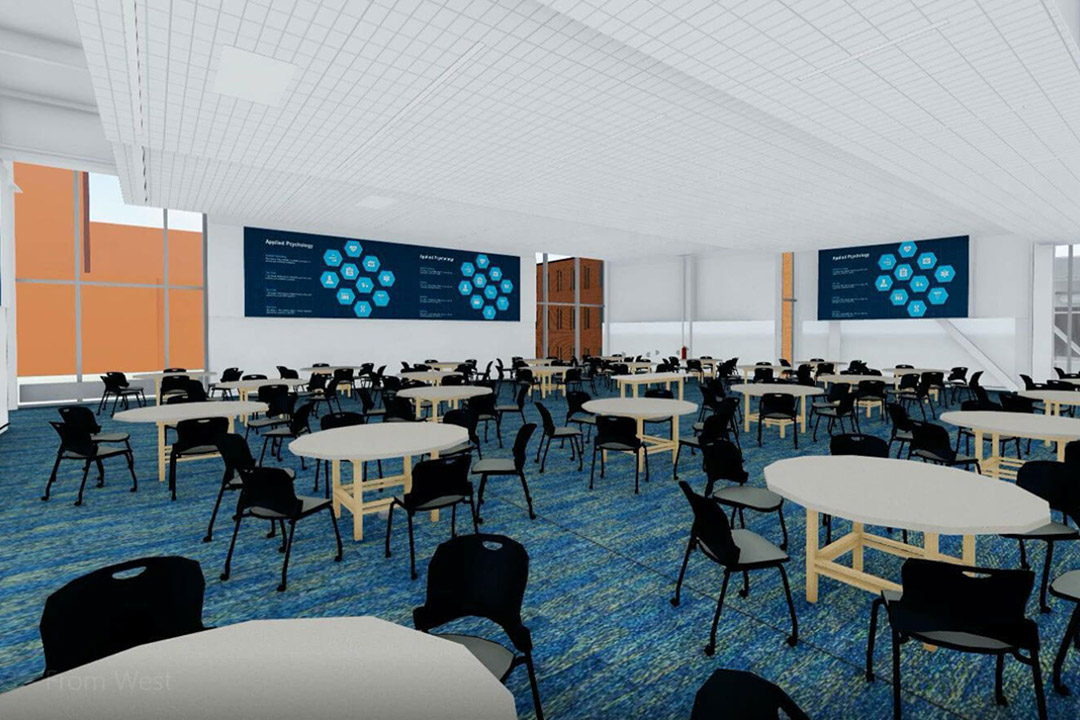Simulated SHED classroom previews new learning space
William Rawn Associates
Classrooms in the Student Hall for Exploration and Development (SHED) will promote student engagement through active learning in traditionally large courses or newly combined sections. Four of the rooms will have a flat configuration, and one will have tiered seating. A SHED beta-room in Slaughter Hall will give faculty and students a preview next academic year of the new large-scale learning spaces available in the SHED in fall 2023.
Walking into the extra-large classrooms in the Student Hall for Exploration and Development (the SHED) will be a new experience for students and faculty alike when the multi-use complex opens its doors in fall 2023. The classrooms, located on the third and fourth floors, will cap the makerspace, performing arts rooms and studios, and student team workspaces.
Faculty can preview the new learning environment during the 2022-2023 academic year by teaching in a large-capacity learning space designed to simulate the new active learning spaces in the SHED. The beta, or test, classroom will be located in Slaughter Hall, room 2230, and will combine four regular-sized class rooms.
The space will be converted for the fall semester to seat 120 students in groups of six. Classes will be held in the space from 8 a.m. to 8 p.m. Tuesday and Thursday in the fall and Monday through Friday during the spring. Fall courses in the beta room will include university-wide general education courses as well as courses with multiple sections, such as principles of data management, introduction to visual arts, general biology, and circuits 2.
“The courses are a good distribution from across the colleges,” said RIT vice provost Christine Licata. “They consist of entry-level courses to graduate level. Some of the instructors are experienced with large-scale active learning, and others are new to it.”
At 40,000 square feet, the SHED’s five jumbo-sized classrooms will mark the largest contiguous instructional spaces on campus. Only one of the classrooms will have tiered seating; the remaining four classrooms will be flat, with trapezoid tables on wheels to accommodate groups of three or six students.
In contrast, traditional lecture halls, such as the College of Science’s Van Peursem Auditorium, are designed with tiered furniture to maximize capacity. Van Peursem can hold 250 students in a setting conducive for lectures over small group activity.
The flat classrooms in the SHED will seat 150 students (30 more than in the beta classroom) at the same level as the faculty leading the class. Audio/visual equipment will be tucked inside a credenza instead of within a podium at the front of the room, freeing up the space for a dynamic learning environment in the beta classroom and in the regular-sized classrooms in Wallace. (The SHED classrooms will have both a credenza and a podium.) The beta classroom will have screens and moveable whiteboards that will also be used in the SHED.
The SHED Classroom Utilization Team, led by Licata, worked with college leadership and department chairs to identify large courses or courses with multiple sections that lend themselves to active learning. This popular pedagogical approach asks students to participate in learning through small group activities. Sandi Connelly’s general biology course regularly breaks into small groups to conduct table-top experiments, such as a yeast-and-sugar experiment using balloons to explore cellular respiration. The fixed furniture in the Van Peursem Auditorium makes group work challenging, Connelly said, describing students leaning over rows of seating or working together between different levels.
The same experiments conducted in a flat-level room would provide a different experience for the students, said Connelly, principal lecturer in the Thomas H. Gosnell School of Life Sciences and a member of the SHED classroom team.
Connelly attributed a generous spirit to her colleagues who agreed to rearrange their schedules to allow other classes to fill their time slots in the beta room, especially during the most popular class times on campus—9:30 a.m. and 11 a.m. on Tuesday/Thursday. “Some of these classes have been offered at these times for 15 years,” Connelly said.
Deans’ leadership teams and department chairs worked with faculty to ensure the courses scheduled in the beta classroom align with student and faculty schedules.
The SHED committee picked the suite of rooms in Slaughter Hall because it was the largest, flat learning space available. The beta classroom will be about 25 percent smaller than the actual classrooms in the SHED.
One-level rooms this large are new for RIT, and the SHED team is counting on peer-to-peer communication to help spread interest among faculty.
“We hope that once the SHED opens, the demand for these large classrooms will exceed our capacity,” said Neil Hair, associate professor of marketing and executive director of RIT’s Center for Teaching and Learning. “The beta classroom helps us build support and enthusiasm and creates an opportunity to provide instructional support.”
Professors from other universities with similar spaces will share their experiences and offer best practices during faculty training and workshops on active teaching in large-format classrooms. These sessions will take place in the summer and during the 2022-2023 academic year.













